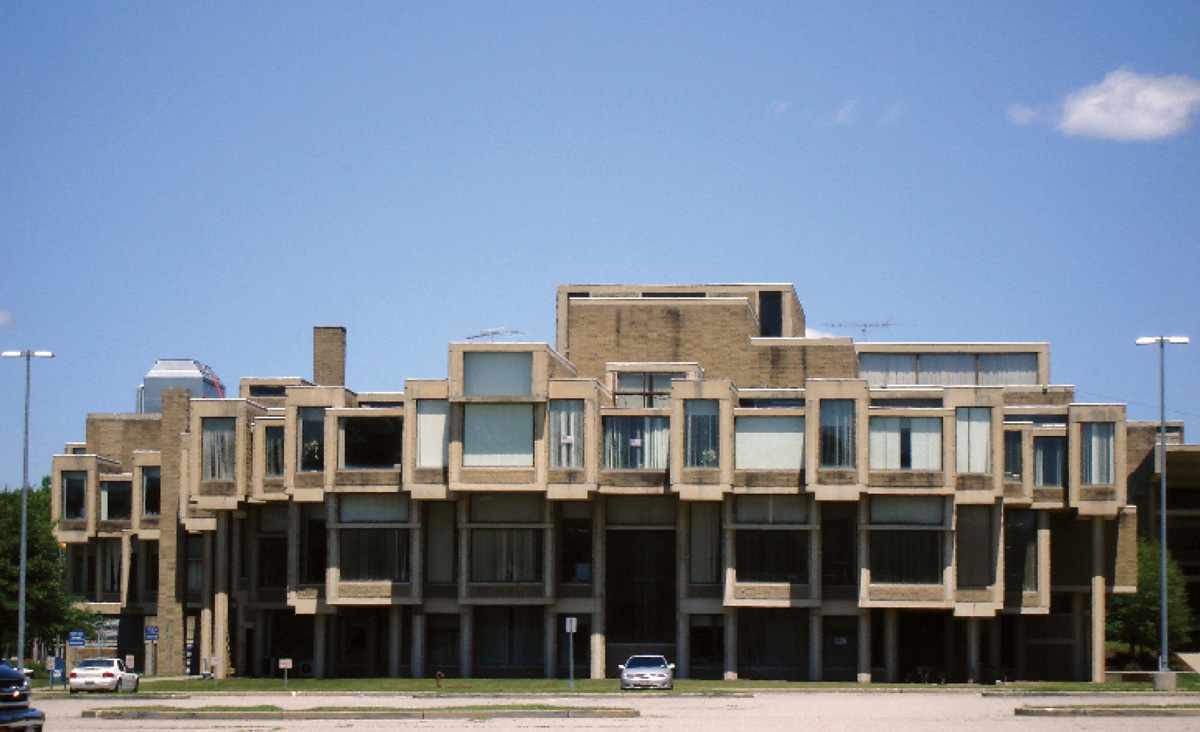Black Pyramid / Concrete & Cement
Form and Spectre
Peter Lamborn Wilson
“Black Pyramid” is a column by Peter Lamborn Wilson on the poetics of esoterica.
The Roman Empire invented concrete, a substance in fact already known to the Egyptians, to “solidify with the minimum of voids” a world all too porous and fluid, to make space itself more dense and compacted in heavy auras that still hover round Roman ruins. Concrete may even warp time by altering gravitational fields. The secret was lost and not rediscovered until the nineteenth century, needless to say. Paradoxically, concrete time speeds up, not down. Then it collapses.

Natural cement was discovered in Rosendale, New York, circa mid-1820s, and used to create the concrete that built much of New York City, including the Brooklyn Bridge, that first thought, best thought of Modernism. The Rosendale biome was pierced and scored with canals and mines. Kilns smoldered in the hills, a nightly Bosch-scape of Satanic mills. Progress uncovered a nest of Rip van Winkles lost in the backwoods since the seventeenth century: Dutch drop-outs, Hessian deserters, runaway slaves, rogue Algonkins, all mixed and known to eugenics theory as “the Jukes.”
After Rosendale’s boom came the sudden ascendancy in the 1870s of artificial Portland cement. The Delaware & Hudson Canal dried up. Time collapsed around the village. Portland cement is weaker than the natural stuff, but faster drying, making it ideal for twentieth-century capitalism with its illusory lightness and airiness, secretly deploying malign alchemical forces to make consumerism into the dominant ideology, concretize the imaginal, and use it to oppress the masses with the heavy hard time of rationalized labor.
Not to say concrete’s bad in itself. Blake insists everything has its Form and its Spectre. Blakean geniuses use cement’s bounding line to depict visionary space: Simon Rodia’s Watts Towers, for instance, or the concrete fantasy gardens of crazy Wisconsin and Iowa, or Gaudí’s incomplete cathedral—form without function except on psychic levels symbolizing matter’s attempt to merge with imagination and vice versa. Grotesque concrete. Surreal cement.
Roman concrete must have been invented by Hermeticists. Its recipe expresses all four elements— fire in the form of pozzuolana or volcanic earth; water as the lime slurry; earth in the gravel and crushed brick; air in the volcanic tuff. Thus it can be seen as alchemical artificial “perfect” stone, an improvement or refining of Nature, a quickening of her slow movements, like instant stalagmites. This would explain its resonance (both positive and negative) with Imagination. Hence also its use in the Pantheon of Rome—the dome as heaven; the syncretism of “all the gods” as memory theater; magic used to empower Imperium.
Modern ferroconcrete incorporates the metal of Mars or Marduk, gods who preside over war and the emergence of the Iron Age—civilization as hegemony again; the idea of empire. It is no coincidence that cement and iron expand and contract under temperature change at the same rate. “Compressive stresses are sustained by the concrete and the tensile stresses resisted by the steel,” says the Columbia Desk Encyclopedia: an expression of the Hermetic dialectic. Hermetic secrets that fall into the hands of Power (whether church, state, or corporation) have their values reversed, form to specter, gold to feces. Instead of Watts Towers or buildings in the shapes of ducks and elephants (once so popular in the US) we get the titanic Prometheanism of post-Bauhaus twenty-first-century neo-Brutalism, building as machine to reshape human consciousness not toward autonomy, pleasure, or wonderment, but uniformity and work (with a bit of PoMo froufrou thrown in to distract the attention of viewers from the Same Old Big Box). Imperium again and again, the Roman triumphalism of the Global Empire of Pure Kapital, first in its Stalinoid “International” form, then as “Irony.” (Marx might say, “second time as farce.”) Surely Disneyland would not be possible without ferroconcrete. Nor the World Trade Center towers. Pure Image Magic.
After the 1880s, Rosendale slipped imperceptibly back into the slough of Jukish timelessness for half a century or more, during which the cement mines and furnaces fell into picturesque ruin—a whole decline and fall in miniature. Progress took itself off elsewhere. Cement/concrete moved up the river to Greene County, to Cementon on the Hudson. Today, there’s a very heavy psychic aura up there; last vestiges of twentieth-century titano-industrial spaces bend the light over the valley into gray zones.
But even in this New Cyber Age, capital has still not outgrown its need for cement and other remnants of the Old Economy. Far from it. If heavy industry has almost vanished from our privileged region, it’s not because the whole world is growing Greener. The demise of small industry and small farming in New York has allowed forest to spread; real estate has become more important than production, so the verdant “viewshed” must be preserved. I confess to conflicting emotions: I don’t want to live near any cement factories. I’m glad I can afford (barely) to stay in an area where sprawl is resisted—if not always successfully—and environmental concerns are politically hot. But I know it’s a luxury. I know that the cement factories will simply be shunted off to Mexico.
Moreover, a subtle miasma hangs over the whole concept of “preservation,” the transformation of nature into spectacle, the museumization of the past, green tourism, heritage tourism, the picturesque as “resource,” view as commodity. Are we the colonizers of our own Washington Irving Xmas card? Tourists-in-place? Passive scopophiliacs? If we add nothing beautiful to the landscape, does what we preserve turn into mere inauthenticity and parodic self-representation?
Blake says Imagination is the world we live in, not some abstract realm of ideas. Those who refuse this knowledge are condemned to live in someone else’s idea, concretized in concrete.
Actually we now live inside the idea of money, i.e., inside money’s own image of itself—which accounts for the eerie “post-human” look of the new globalism. The tools with which this idea is expressed have been cyberized in an attempt to achieve the machine’s own image of itself as pure money. Concrete is flexible enough to be shaped into these abstractions, these buildings without organs. So concrete still rules our destinies. Civilization would have been impossible in Sumeria without clay, “the first plastic.” Concrete is an alchemical preparation of this clay. The Roman Empire that perfected this plastic “never died,” as the lunatic Sci-Fi Gnostic illuminatus P. K. Dick used to insist. It went into remission during the “Dark Ages”: Chartres uses no concrete. But concrete survives and always takes new forms. In a sense the Church tried to suppress it, but eventually became it (as in the churches of Le Corbusier). Capitalism, based on Roman laws of property, inherits the lost secret of concrete.
Who was that John Smeaton who rediscovered hydraulic concrete in 1756? Maker of navigational instruments, he rebuilt the Eddystone Lighthouse with his amazing new stuff. Was he the “keeper of the Light” who “married a mermaid one fine night”? Was he a Royal Society Freemason? Was he a thief of Hermetic secrets in the service of power?
Too bad the Jukes got mixed up with cement. They tried to evade civilization by living like Indians up in the Binnewaters but found themselves stuck in the way of Progress. The eugenicists discovered them and made up the name Juke and made it a byword for backwardness, rural petty crime, incest, zero-work mentality, mixed blood, bad blood. Other drop-out “isolate” communities around here went unnoticed, like Pang Yang or the Eagle’s Nest, because they weren’t sitting on such valuable real estate. A few such strange hamlets persist today—I could name names. But I prefer to keep them roughly secret; in fact, I rather aspire to such status myself. I’d like to get out from under the sign of concrete and degenerate into the true American way of life: “Gone to Croatan.”

The trick to living such a life would be to evade all the major technologies based on theft of Hermetic secrets. Ben Franklin, that Freemason member of the Hellfire Club and the Royal Society, stole electricity. Internal combustion was filched by Christian Huygens (d. 1695), another scientific instrument-maker who discovered Saturn’s rings, opposed Newton’s corpuscular theory of light with a wave theory, and designed an engine to run on gunpowder explosions. Gunpowder was attributed to the alchemists Roger Bacon and Berthold Schwarz, but they learned it from Arab Hermeticists who learned it from the Chinese, who used it to exorcize demons (and still do). But even metallurgy was once an alchemical secret (see Eliade’s Forgerons et alchemistes), and it was used to create the very basis for the emergence of hegemonic civilization. (Hence the uncanniness of mines, miners, and smiths, and the abhorrence of all “primitives” for the “rape of the earth” involved in mining metals.) Reversion to Stone Age tech and its nonauthoritarian communitas seems similarly impossible, short of an “end” to civilization itself.
But at least we can try to cultivate a Hermetic critique of substances and techniques. Having learned to live without these technologies, it might then prove possible to reappropriate them and liberate them in the sense that Gaudí liberated concrete. The concept of the “sick building,” now discussed as a matter of bad lighting or ventilation, should be enlarged to include an alchemical analysis of the structure (the shape) of the building and its materials. Living space becomes antibiotic under certain conditions, just as other aspects of environment are polluted by poisonous airs, lights, and noises. Local premodern vernacular building is always trustworthy and always in good taste (e.g., the wigwam, Dutch stone house, English barn).
Vast concentrations of steel and concrete create negative energy basins. In such a context, architecture must go on the occult defensive: perhaps blood sacrifices on the cornerstones or horse skulls buried under floors! Reich’s theory about the orgone accumulator or “box” as a composite of organic and inorganic materials might reveal that ferroconcrete actually attracts and traps negative or “deadly” orgone rays. In theory, one could design a spagyric house. Joseph Beuys, himself an alchemist, Anthroposophist, and anarchist, might call this “social sculpture.” Note his use of stone and living trees in his 7000 Oaks project of urban renewal. One of the earliest uses of concrete in American architecture was the Octagon House of Orson Fowler, you guessed it, an occultist anarchist (and phrenologist). It was a buckyfuller dome for the mid-nineteenth-century “first” New Age of Reform and Spiritualism, a house for the People, eccentric and jewel-like, but actually quite livable and cheap to build. Concrete as shaped by visionary and self-taught architects may prove to be possible in alchemical building, if used with full consciousness of its occult significance.
Peter Lamborn Wilson is the author of many books, including “Shower of Stars” Dream & Book: The Initiatic Dream in Sufism and Taoism (Autonomedia, 1996), Escape from the Nineteenth Century (Autonomedia, 1998), and Ploughing the Clouds: The Search for Irish Soma (City Lights, 1999).
Spotted an error? Email us at corrections at cabinetmagazine dot org.
If you’ve enjoyed the free articles that we offer on our site, please consider subscribing to our nonprofit magazine. You get twelve online issues and unlimited access to all our archives.